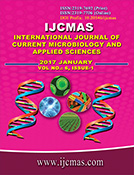


 National Academy of Agricultural Sciences (NAAS)
National Academy of Agricultural Sciences (NAAS)

|
PRINT ISSN : 2319-7692
Online ISSN : 2319-7706 Issues : 12 per year Publisher : Excellent Publishers Email : editorijcmas@gmail.com / submit@ijcmas.com Editor-in-chief: Dr.M.Prakash Index Copernicus ICV 2018: 95.39 NAAS RATING 2020: 5.38 |
Pisonia alba commonly known as Leechikottaikerai in tamil is a widely used plant. In the alternative system of medicine Pisonia alba leaves are used as anti-inflammatory, anti-diuretic and antifungal. Mukia maderaspatana is an important traditional medicinal plant used generally in Western districts of Tamilnadu. It has properties like anti-rheumatic, antiflatulent and anticancer also. The present study was carried out to investigate the phytochemical screening, antioxidant and antimicrobial activity of aqueous and ethanolic extracts of the leaves of both the plants. The phytochemical analysis of the leaf extracts of Mukia maderaspatana and Pisonia alba revealed the presence of tannins, saponins, quinines, flavanoids, cardiac glycosides, phenolic acids, terpenoids, coumarins, steroids and betacyanins. The results showed that the phytochemical properties of the leaves have the potency of being used in the health industry. The strongest radical scavenging activity(76.4%) was exhibited by the ethanolic extract of Pisonia alba, moderate activity(59.8%) was recorded in ethanolic extract of Mukia masderaspatana and weakest activity(51.2%) was exhibited by the aqueous extract of Pisonia alba followed by aqueous extract of Mukia maderaspatana(46.4%). The zone of inhibition by disc diffusion method were measured for determining antimicrobial action of ethanolic extracts of Pisonia alba and Mukia maderaspatana leaves against Bacillus cereus, Bacillus subtilis, Escherichia coli, Pseudomonas aureginosa and Staphylococcus aureus. Among the various extracts, maximum antimicrobial activity was exhibited by ethanolic extract of Pisonia alba followed by ethanolic extract of Mukia maderaspatana.
 |
 |
 |
 |
 |